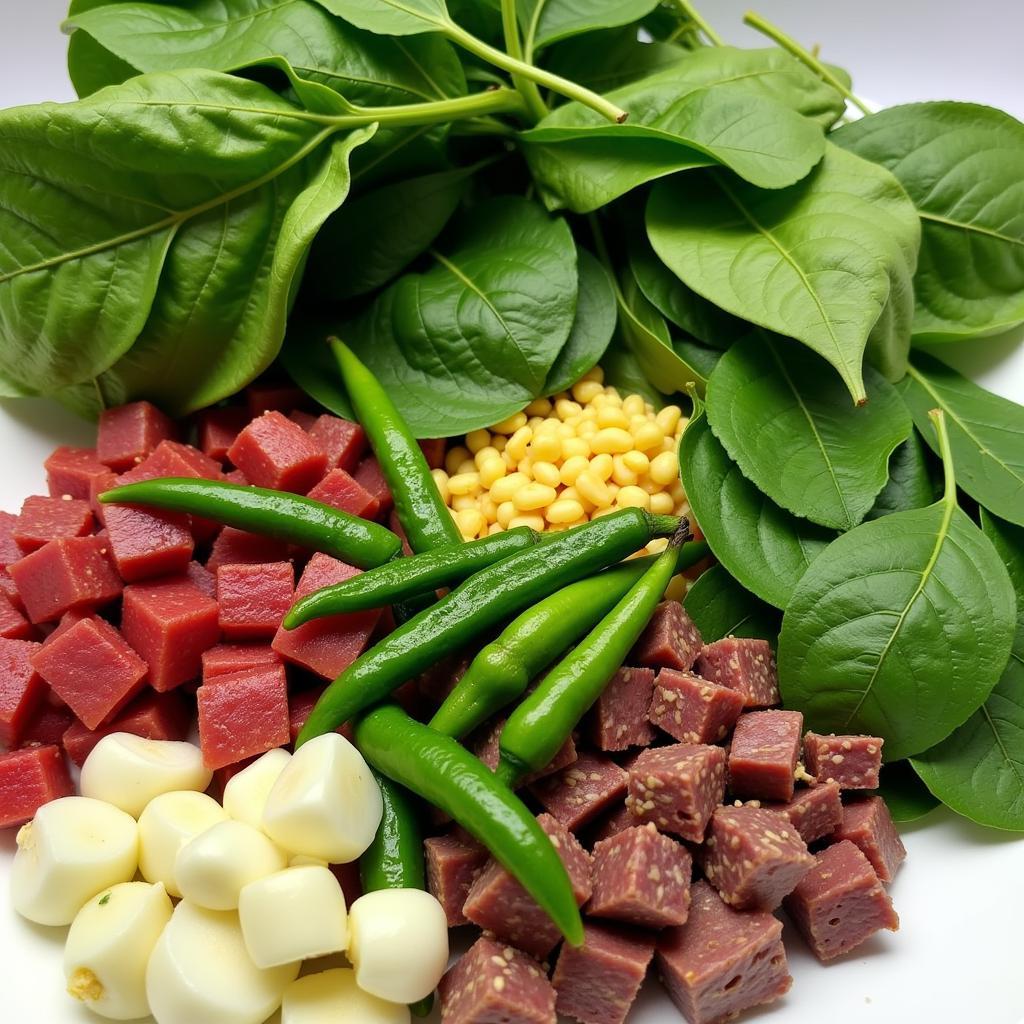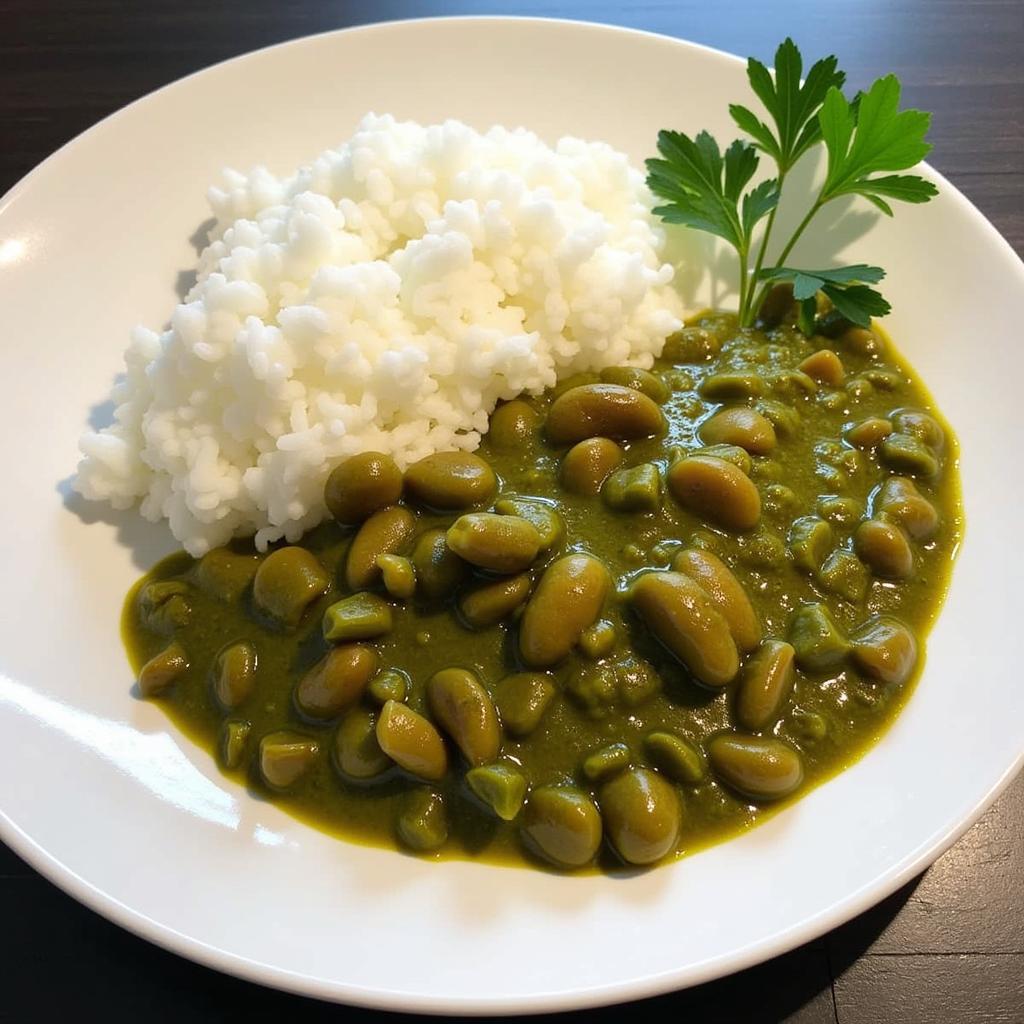Legume Lalo Haitian Food, a vibrant and flavorful stew, is a cornerstone of Haitian cuisine. This rich dish, featuring jute leaves (lalo), various meats, and a medley of aromatic spices, offers a unique taste of Haitian culture and culinary traditions. From its humble origins to its celebrated place on the Haitian table, let’s dive deep into the world of legume lalo.
 Fresh ingredients for Haitian Legume Lalo
Fresh ingredients for Haitian Legume Lalo
What is Legume Lalo Haitian Food?
Legume lalo is more than just a stew; it’s a celebration of Haitian flavors. The star ingredient, lalo, consists of finely chopped jute leaves, giving the stew its signature earthy, slightly spinach-like flavor and a rich, dark green hue. This leafy green is packed with nutrients and adds a unique texture to the dish. Combined with tender meat, usually beef, goat, or crab, and a fragrant blend of spices, including onions, garlic, and scotch bonnet peppers, legume lalo provides a complex and satisfying culinary experience.
caribbean food st petersburg fl
The History and Cultural Significance of Lalo
The history of legume lalo is intertwined with Haiti’s rich cultural heritage. Jute, the plant from which lalo is derived, has a long history of cultivation in the region, dating back centuries. Lalo is often associated with celebrations and special occasions, signifying abundance and prosperity. It’s a dish that connects generations, passed down through families, preserving culinary traditions and stories. This hearty stew also represents resilience, providing sustenance and comfort during challenging times.
How is Legume Lalo Prepared?
The preparation of legume lalo is a labor of love. It involves carefully cleaning and chopping the jute leaves, browning the meat, and creating a flavorful base with aromatic spices. The stew is then simmered slowly, allowing the flavors to meld and deepen. This slow cooking process enhances the tenderness of the meat and creates a rich, velvety texture.
What Does Legume Lalo Taste Like?
Legume lalo offers a unique flavor profile that is both earthy and vibrant. The jute leaves contribute an earthy, slightly spinach-like taste, while the spices add warmth and depth. The scotch bonnet peppers provide a touch of heat, balanced by the richness of the meat and the other vegetables. The combination of these flavors creates a complex and satisfying culinary experience. Imagine a hearty, savory stew with a hint of spice and a unique, almost smoky undertone. That’s the magic of legume lalo.
caribbean food st petersburg fl
Where Can I Find Authentic Legume Lalo?
While you can certainly try your hand at making legume lalo at home, experiencing the authentic flavors of this dish often means finding a Haitian restaurant or a home cook specializing in Haitian cuisine. These are the places where you’ll find the time-honored recipes and techniques that truly capture the essence of legume lalo.
Legume Lalo: A Culinary Journey to Haiti
From its humble ingredients to its complex flavor profile, legume lalo Haitian food offers a unique and rewarding culinary experience. It’s a dish that tells a story of Haitian culture, tradition, and resilience.
“Legume lalo is more than just a dish; it’s a taste of home, a connection to our heritage.” – Marie Claude Joseph, Haitian Culinary Historian
Legume Lalo Variations and Accompaniments
While the traditional preparation of legume lalo remains a cherished classic, there are regional variations and accompanying dishes that add even more depth to this culinary experience. Some variations incorporate seafood, like crab or conch, while others add different vegetables like okra or spinach. Legume lalo is often served with rice, plantains, or griot (fried pork), creating a complete and balanced meal.
 A plate of Legume Lalo served with rice
A plate of Legume Lalo served with rice
“Every family has their own special touch, their own secret ingredient that makes their legume lalo unique.” – Jean-Pierre Louis, Haitian Chef
Conclusion: Experience the Magic of Legume Lalo Haitian Food
Legume lalo is more than just a stew; it’s a culinary journey to the heart of Haitian cuisine. So, whether you’re a seasoned foodie or simply curious to explore new flavors, discover the magic of legume lalo and experience a taste of Haiti’s rich culinary heritage.
FAQ
- What is lalo made of? Lalo is made from finely chopped jute leaves.
- Is legume lalo spicy? It can be, depending on the amount of scotch bonnet peppers used.
- What is legume lalo usually served with? Rice, plantains, and griot are common accompaniments.
- Where can I find jute leaves? You may find them in specialty Caribbean markets or online.
- Can I make legume lalo vegetarian? Yes, you can omit the meat and use vegetable broth.
- How long does it take to make legume lalo? It typically takes about 1-2 hours to prepare and cook.
- Is legume lalo healthy? Yes, it is packed with nutrients from the jute leaves and vegetables.
Need support? Contact us at Phone Number: 02437655121, Email: minacones@gmail.com or visit us at 3PGH+8R9, ĐT70A, thôn Trung, Bắc Từ Liêm, Hà Nội, Việt Nam. We have a 24/7 customer service team.